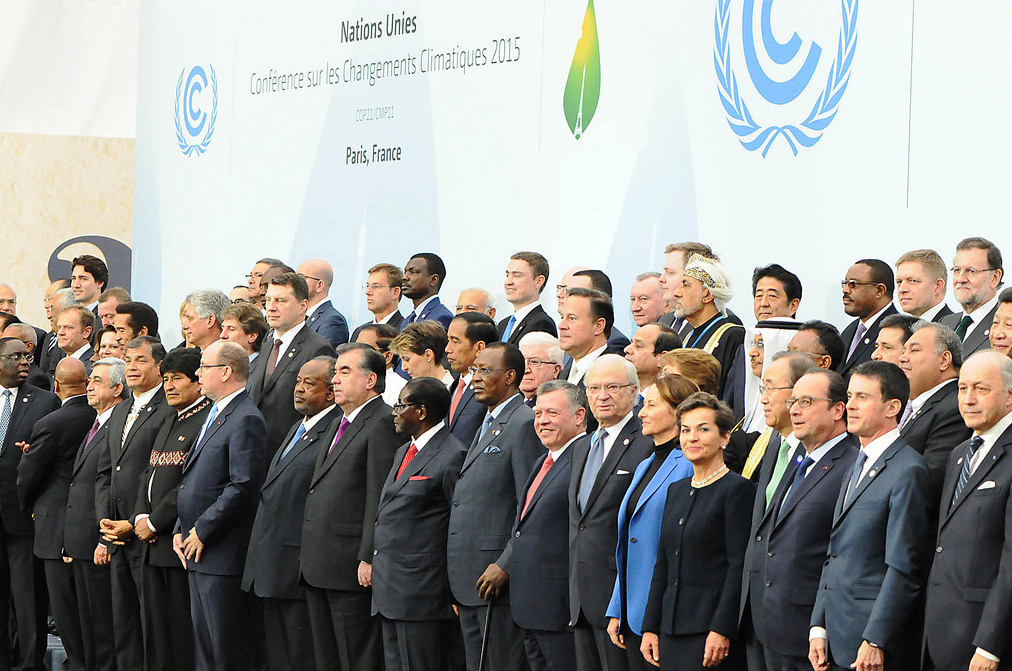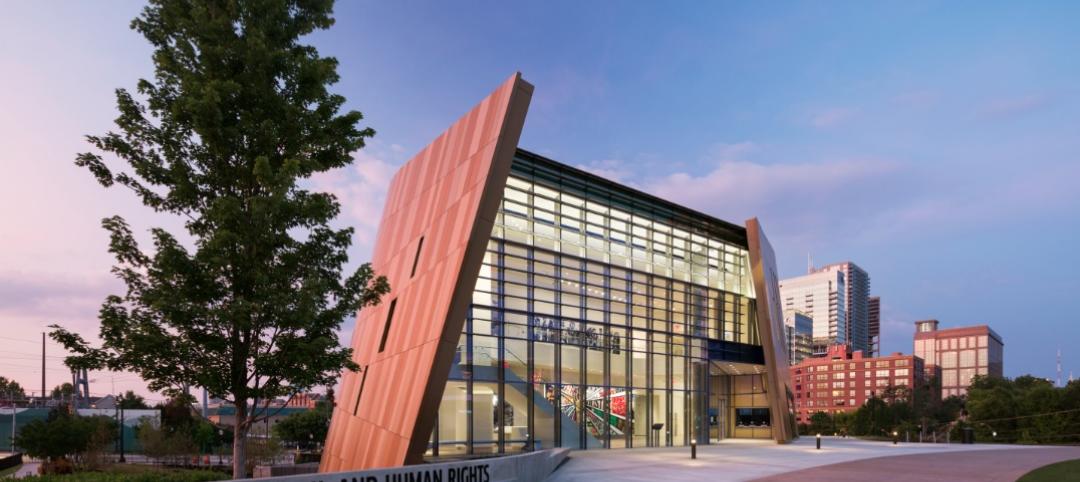In the wake of President Trump’s unilateral decision to withdraw the U.S. from the 2015 Paris Climate Agreement, many in the building industry have optimistically pointed to unstoppable market forces pushing the sector towards a post-carbon future.
Immediately after the announcement, the American Institute of Architects and the U.S. Green Building Council issued separate press releases reaffirming their organizations’ commitments to energy efficiency and renewable energy.
Building product manufacturers such as Interface, Johnson Controls, and Kohler joined developers like Skanska, Jonathan Rose Companies, Winkler Development Corporation, Wynkoop Properties, LLC and more than 900 other companies, 100 Mayors, 150 universities, and nine states to sign the massive “We Are Still In” open letter to the international community. This statement reaffirms the commitment of a broad swath of the economy and society to following through with the greenhouse gas reductions and climate resilience strategies that were negotiated as part of the Paris Agreement.
Leaders in the real estate sector see both short- and long-term advantages to taking this stance. In the short term, energy efficiency lowers operating expenses. Over the long term, buildings that are designed to reduce the impact of future heat waves, power outages, high winds, and flooding will likely benefit from lowered insurance premiums.
In response, projects are beginning to use tools such as Health Impact Assessments to design buildings that protect occupants from the health concerns related to climate change that vary from one location to the next—issues like air pollution, heat waves, the drought/flood cycle, and disease-carrying insects.
Given the acknowledged value of climate sensitive design to real estate investments, it is tempting to simply write off the federal government’s participation in climate change efforts, at least for the next 3+ years. However, before we walk down that road, it is useful to pause for a moment to consider what the building sector stands to lose if the federal government stops participating in the movement to build a climate sensitive society.
The Building Industry is Central to the Paris Agreement
Real estate played a significant role in climate change negotiations, as evidenced by the Global Alliance for Buildings and Construction, which was launched at COP21 in Paris. Its clout stems from the fact that the building sector is simultaneously a major contributor to greenhouse gas emissions (GHGs), the largest source of financial losses when natural disasters strike, and the physical shelter protecting (or, tragically, trapping) individuals during climatic events.
According to the U.S. EPA, it is responsible for more than 30% of U.S. GHGs annually, primarily through the use of electricity and heating oil for building operations. Furthermore, if transportation is included (since the location of buildings relative to each other is a major factor in the type of transportation used to move people and goods from one location to another), what is collectively called the built environment accounts for fully 60% of total U.S. GHGs.
Buildings and infrastructure also make up the majority of losses claimed through the Federal Emergency Management Agency (FEMA) after climatic events. And, that amount is growing. The annual average of billion-dollar events from 2012 to 2016, 10.6, is almost twice the long term average of 5.5 from 1980 to 2016.
While it may seem obvious that the purpose of buildings is to shelter their occupants from the elements, it is worth considering the building stock’s current level of performance when the power and water have been cut off. Some of the most tragic news stories from Hurricane Katrina and Superstorm Sandy related the ordeals of patients and residents trapped in buildings after the power and water went out. The cost to society of a building failing to protect its inhabitants during a natural disaster can be significant. For example, a 2011 study estimated that the medical expenses associated with just 6 extreme weather events from the previous decade amounted to $14 billion above and beyond the costs that are typically accounted for in FEMA estimates.
Design decisions also play a role in many of the indirect health effects of climate change. For example, both climate change and the built environment played a role in transmission of the Zika virus in 2016 – climate change by lengthening the number of days that the primary carrier mosquito can transmit the disease; and, the built environment by regulating exposure to Zika-carrying mosquitoes through measures such as air conditioning, window screens, and regularly cleaning or throwing away any outside receptacles that could hold water.
And, the Federal Government is Central to De-carbonizing the Building Industry
If the building industry is aligned with other areas of private industry in a commitment to move away from fossil fuels, then why the furor over the U.S. federal government pulling out of the Paris Agreement?
While it is true that most of the action on climate change is taking place at the state and local level, the federal government plays a pivotal role in coordinating action across the country. For example:
1. While building codes are set at the local level, the federal government sets baseline performance standards for energy efficiency targets, renewable energy generation, flood safety measures, and other elements of land use policy that reduce GHGs and protect building occupants during and after extreme weather events. In order for the real estate sector to meaningfully contribute to the Paris Agreement, carbon neutral building, neighborhoods, and communities must become the norm. By withdrawing the U.S. from the Paris Climate Agreement, the Trump Administration is signaling that federal agencies will no longer coordinate that transition. As a result, real estate developers working in multiple jurisdictions could face a growing disparity in regulations as some regions (such as cities that signed on to the Mayors National Climate Action Agenda) accelerate regulations phasing in carbon neutral requirements in an attempt to offset the lack of progress in other areas of the country.
2. The federal government is the ultimate technology accelerator. It can use financial instruments such as subsidies, grants, and challenges to channel research into solving the large, remaining questions about de-carbonization, such as – How can we decentralize the electrical grid? How will we redevelop urban and suburban areas to reduce car use? How can existing buildings be retrofitted to increase energy efficiency and passive survivability (i.e., continuing to function after the power goes out)? President Trump’s proposed budget ignores questions like these that are looking towards the future, doubling down instead on subsidies to the fossil fuel industries of the past. The result, if accepted by Congress, places the U.S. clean energy and green building industries at a disadvantage compared with other countries.
3. The federal government is often the place where new building technologies are brought to scale for the first time. The General Service Administration (GSA) owns or leases over 375 million square feet across 9,600 buildings. Due to its sheer size, it can sway the marketplace by simply adopting an innovative policy. For example, the GSA’s work testing energy efficiency, water efficiency, indoor air quality, and sustainable materials innovations have influenced the growth of the green building industry since the 1970’s. It is currently working towards achieving carbon neutrality by 2030, a goal that may fade in the current political climate – with corollary repercussions to the entire building industry.
4. Finally, the federal government collects and standardizes most of the data that is used to quantify improvements in energy efficiency, renewable energy, indoor air quality, and the health effects associated with building design. The federal government’s role in spurring the explosion of technologies using big data over the past five years cannot be overstated, including in the real estate industry. There is growing demand among developers, financers, and owners to quantify the benefits of designing net-zero, healthy buildings. Gathering data locally is expensive. And, unless a single set of guidelines are followed, it is impossible to compare one jurisdiction with another. Even if data is collected at the building scale to track performance, chances are that the reference baseline data originated in a federal database. The trend in the Trump administration is against data collection and dissemination. And, without the need to track progress towards Paris Agreement commitments, federal agencies may no longer feel pressure to update key data sets or even share historical records.
Cities, states, and industry should be celebrated for their courage and resolution to continue moving the U.S. along the path to meeting and exceeding the commitments pledged by the Obama Administration.
However, for the reasons outlined above, among others, it is important to continue pushing the Trump Administration to reconsider the decision to withdraw from the Paris Agreement. Perhaps the language of real estate will change President Trump’s mind, as he begins to see the negative repercussions of his decision on his “home” sector of the economy.
About the Author: Adele Houghton, AIA, MPH, LEED AP BD+C, O+M, ND, is President of Biositu, LLC, a strategic consulting company dedicated to leveraging environmental sustainability to enhance community health. She is a licensed Architect in the state of Texas and a LEED Accredited Professional with specialties in Building Design & Construction, Operations & Maintenance, and Neighborhood Development. She received a Master of Public Health and a Certificate in Public Health Informatics from Johns Hopkins Bloomberg School of Public Health.
Related Stories
Green | Feb 4, 2015
Illinois leads top 10 states for LEED green building
Collectively, 1,662 commercial and institutional projects became LEED certified within the top 10 states in 2014, representing 251.7 million sf of real estate.
Energy Efficiency | Jan 28, 2015
An urban wind and solar energy system that may actually work
The system was designed to take advantage of a building's air flow and generate energy even if its in the middle of a city.
Sponsored | Green | Jan 26, 2015
Shopping centers set their sight on solar
As part of its pledge to environmentally sound practices, real estate investment trust Macerich is implementing solar across its portfolio of 85-plus properties in 19 states.
| Jan 21, 2015
Tesla Motors starts construction on $5 billion battery plant in Nevada
Tesla Motors’ “gigafactory,” a $5 billion project on 980 acres in Sparks, Nev., could annually produce enough power for 500,000 electric cars.
| Dec 29, 2014
Leo A Daly's minimally invasive approach to remote field site design [BD+C's 2014 Great Solutions Report]
For the past six years, Leo A Daly has been designing sites for remote field stations with near-zero ecological disturbance. The firm's environmentally delicate work was named a 2014 Great Solution by the editors of Building Design+Construction.
| Dec 28, 2014
Using energy modeling to increase project value [AIA course]
This course, worth 1.0 AIA LU/HSW, explores how to increase project value through energy modeling, as well as how to conduct quick payback and net present value studies to identify which energy strategies are most viable for the project.
| Dec 23, 2014
5 tech trends transforming BIM/VDC
From energy modeling on the fly to prefabrication of building systems, these advancements are potential game changers for AEC firms that are serious about building information modeling.
| Dec 19, 2014
Zaha Hadid unveils dune-shaped HQ for Emirati environmental management company
Zaha Hadid Architects released designs for the new headquarters of Emirati environmental management company Bee’ah, revealing a structure that references the shape and motion of a sand dune.
| Dec 18, 2014
International Parking Institute and Green Parking Council collaborate with GBCI
The new collaboration recognizes importance of sustainable parking facility design and management to the built environment.
| Dec 17, 2014
USGBC announces 2014 Best of Green Schools honorees
Houston's Monarch School was named the K-12 school of the year, and Western Michigan University was honored as the top higher-ed institution, based on environmental programs and education efforts.
















